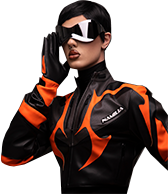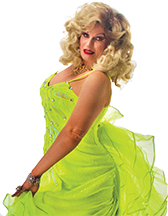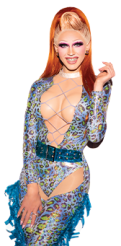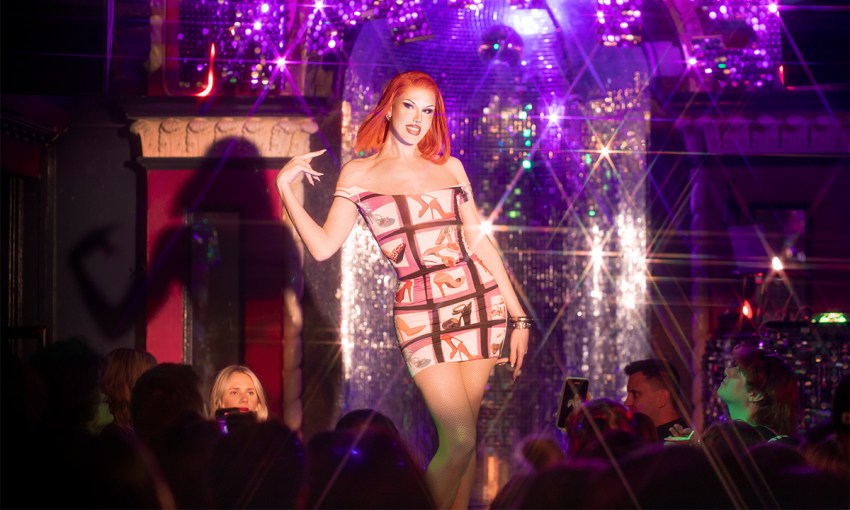Adelaide's drag scene is as versatile as its drag performers. CityMag ventured in and out of the club to get to the core of the culture. What we found was – no surprise – fierce.
Inside Adelaide’s drag scene
One of the first things Kane Enable told CityMag was that she has the gift of the gab. In no moment is that clearer than in the dressing room of Marys Poppin before her Friday night show.
“I started at Marys as an annoying twink!” Kane says.
“I would come out every weekend and see all the drag queens, became friends with all of them, and then it was just like a natural progression into doing drag myself.”
As a queer venue, Marys Poppin facilitates Adelaide’s growing drag community, providing platforms for local and visiting queens.
On the evening CityMag attended, Kane was joined backstage by fellow Marys diva, Eve Elle, and special guests Ivory Glaze and Gabriella Labucci from season three of RuPaul’s Drag Race Down Under.
“We’re very lucky to have so many interstate and international guests come and visit [Marys] when we have that kind of standing,” she says.
“I think a lot of Adelaide drag queens are of a much higher calibre… because there’s less of us, we all meet that standard a lot more.”
Despite wearing a dress patterned with coloured high heels, no one’s walking over Kane as she enters the stage. The room feeds off her energy, which only builds with the crowd.
“My favourite numbers are songs that an audience wants to see,” she says. “If an audience is not enjoying it with you, it’s just not as fulfilling. You want to hear them hooting and hollering for you.”
After the first set, the queens’ path is blocked by the extroverts in the crowd – or the introverts with vodka Red Bull-induced confidence – wanting a pic. The queens happily oblige.
“The biggest misconception with drag queens is that they’re scary or intimidating, but I mean, really, if you go up to them and you have a drink together, that’s all it takes to impress a drag queen,” Kane says.

Kane Enable.
The queens you might see at Marys are reminiscent of – or sometimes exactly – stars of RuPaul’s Drag Race. Drag has taken different forms in the mainstream over time: from Shakespearean performances, camp expression in films like cult classic The Rocky Horror Picture Show, to ‘vogueing’ birthed from the ballroom subculture.
While drag was always entertaining, its spirit stemmed from protest. The art form evolved through grassroots campaigning efforts for the LGBTQIA+ movement.
Kris Del Vayze has been performing since the early to mid-80s – decades before Marys and its divas – and agrees “drag worldwide has always been tied to activism”.
“We’ve always been out there, virtually as a marketing tool if you will, for any sort of cause or thing that the LGBT community have been fighting for,” Kris says.
This was the case during the AIDS era when governments and health authorities were doing “so very little” towards HIV and AIDS research.
“We were out there as drag queens running shows and shaking tins… for the HIV cause.”
Despite being a self-described “general nuisance”, there were still plenty of venues that would have her in a pre-Marys Adelaide, like the Edinburgh Castle Hotel, Reactor and Beans Bar.
“There was so, so many different places that were holding drag shows and performances and they were all great and all very welcoming for new and established drag queens alike,” Kris says.

Kris Del Vayze.
Eve Elle is another queen whose drag days span years before Australia legalised same-sex marriage in 2017.
“I remember going to rallies in drag and protesting and fighting for marriage equality rights, and that was a big community bonding experience,” Eve says.
In her 14 years in the drag scene, Eve says she saw the art become more palatable for everyday people commercially, which dwindled the “community spirit”.
“It’s essentially turned [drag] into more of a career and [queens] get paid properly for doing it, which is fantastic,” she says.
“Things have just changed so dramatically… a lot of the grassroots effort has kind of disappeared, which is unfortunate, but there are definitely things that we want to get going to create new opportunities for queens.”
Eve began her drag career as a teen, with a cheeky goal of bamboozling the bouncers at the local gay bar.
At that time, while drag was in pubs and clubs, it was still considered niche. Eve says the only opportunity for drag in the light was Feast Festival or Pride March – which still run annually today, but alongside a much drag-heavier calendar.

Eve Elle.
“I remember having a big fight with my parents. They didn’t want me to get into it because they thought it was something seedy and provocative,” she says.
“They had never met or seen a drag queen before but in their minds the idea of what a drag queen was, was something bad.”
Although Eve’s parents are now fully supportive, many of these connotations remain in a broader landscape. This stems from an unfamiliarity and misunderstanding of the nuanced performers drag queens can be.
“Drag can be appropriate for all different people, but there’s a time and a place for different types of drag. You might do something different in a nightclub [compared to] drag story time or day events,” Eve says.
Local drag king Justin Thyme agrees drag is for everyone. He leans into this by being fun and flamboyant rather than getting hung up on looking like a stereotype of masculinity.
Justin describes himself as a game show host meets Johnny Bravo; a high-energy performer who wears bright colours, sequins, glitter and feathers, simply because he can.

Justin Thyme.
“There are no stereotypes for drag. Drag is everything and drag is anything,” Justin says.
In the CBD, Justin finds venue My Lover Cindi the place for a king. Beyond the city limits, Justin has toured with Hungry Jackie Presents in Murray Bridge, Milang, Port Lincoln and other regional towns to bring the craft to audiences that don’t often get to see it.
“I always have people coming up to me saying, ‘I’ve never seen a drag king before’,” Justin says.
“I love that I’m the first king they’ve seen, and they’ve become open-minded because they didn’t even know it was a thing.”
Justin has a nine-year-old son who has attended drag shows, which Justin says has opened his mind to understanding LGBTQIA+ communities. They’ve even performed a special rendition of ‘Baby Shark’ together.
“He always says, ‘mummy, I love when you dress up as Justin’… he understands that queens are men that dress up as women and he understands that mummy is a woman who dresses up like a man, but she doesn’t want to be a man,” Justin says. “She just enjoys being a character and then I come home and undress and I’m mum again.
“He‘s in a safe space, there is nothing sexualised, but there’s always going to be that small group that are always going to be against what you do and how safe we are… it’s never going to be good enough.”
While it may seem like there are more opportunities for drag performers than ever, there’s still a long way to go. Justin explains a regional venue cancelled their show of Hungry Jackie Presents when they found out it was a drag event.
Keep up with Adelaide’s drag stars and their latest events on Instagram:
“There is still pushback… I really hope it does [change],” Justin says.
“No matter where you are, you see flags, pins, people with voices and I think that makes such a big difference now.
“I tell everyone that I’m a drag king and they say, ‘what’s that?’ So I get my Instagram out and start scrolling and I want people to know.”
Whether you’re a queen or king, contour or bind your chest, or have different venues that embrace you, an overarching sense of community is crucial to the Adelaide drag scene.
“It is important to provide safe spaces for new and upcoming performers, to give them as much help and support as possible,” says Kris. “Because without that help and support, it’s going to die out.
“Like anything, drag is organic, it does evolve, it does change. You know, the days of a permed wig and glittery dress and the feather boa equating to drag has moved on.”






